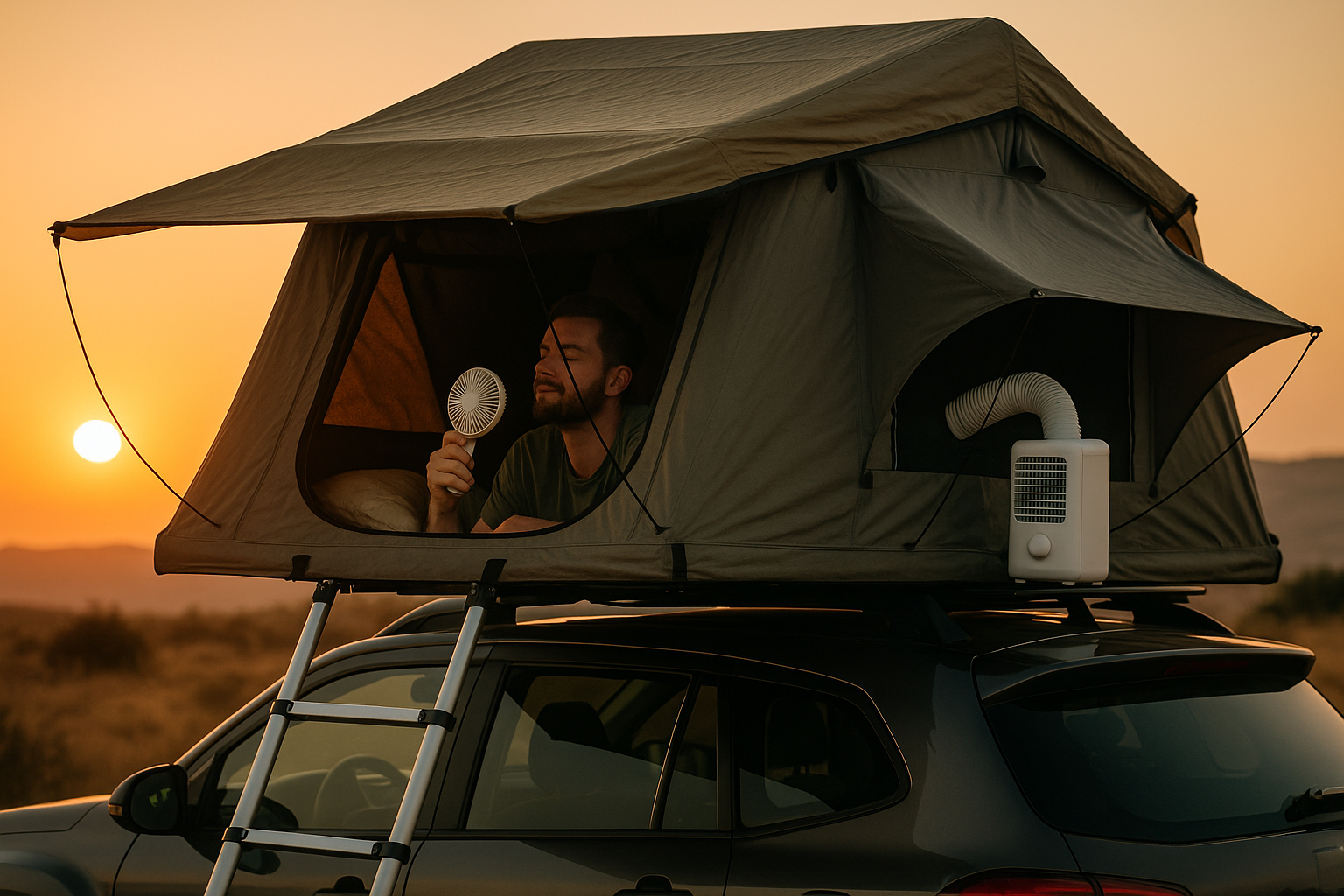The sun’s relentless, the ground’s hot enough to fry an egg, and your rooftop tent feels like an oven. Sound familiar? When a heatwave hits during your camping trip, it can turn even the sturdiest rooftop tent into a stifling sweatbox. But heading for shade or breaking camp isn’t always an option. If you’re serious about camping survival, you’ll need to outsmart the heat—and fast. Here are field-tested, ingenious ways to transform your rooftop tent into a chill zone, using what’s at hand or what you can prep in advance.
1️⃣ Strategic Sun Shielding: Reflect Heat Away Before It Bakes In
The key to beating rooftop tent heat is prevention. Instead of letting the sun bake your tent fabric, create a field-ready heat barrier:
- Use a reflective emergency blanket (Mylar) draped over the tent roof and secured with clips, paracord, or duct tape. Mylar reflects solar radiation and keeps the fabric cooler.
- No blanket? Use a white tarp or light-colored sheet to reflect sunlight. Dark fabrics absorb heat, while light colors deflect it.
- For a makeshift reflective barrier, even foil-lined snack wrappers taped together can work in a pinch.
🛠 Why it works: Deflecting heat before it penetrates the fabric drastically reduces internal temperatures.
2️⃣ Ventilation Voodoo: Cross-Breeze Control
When air’s trapped in the tent, it turns into a sauna. Fix that fast with cross-breeze engineering:
- Open all ventilation points—but angle them to catch even the faintest breeze.
- Use mini car sunshades or cut-up mesh screens to shade vents without blocking airflow.
- If natural breeze is lacking, hang a DIY fan: tie a plastic bag filled with ice or frozen water bottles from the tent ceiling. As the ice melts, it chills the surrounding air and enhances convection.
🛠 Why it works: Moving air carries heat out and fresh air in, creating a natural cooling effect.
3️⃣ Cold Ground Hack: Sleep Closer to Coolness
Heat rises, but the ground (especially shaded earth) holds residual coolness longer. Here’s how to tap into it:
- Deploy a lightweight groundsheet or tarp just under the ladder or near the tent base. Sit or nap with your legs dangling down or feet resting on the cool sheet.
- If your tent has a removable floor or openable side panels, consider opening them to increase exposure to cooler air pockets near the ground.
🛠 Why it works: Maximizing contact with the cooler ground can lower your body temperature during the hottest parts of the day.
4️⃣ Hydro Cooling: Makeshift Evaporative Chillers
Evaporation can work wonders in dry heat. Create a DIY swamp cooler effect inside your rooftop tent:
- Soak a towel, bandana, or spare shirt in water and hang it near vents or drape it inside the tent.
- As the water evaporates, it cools the surrounding air.
- If you have a spray bottle, mist the inside walls lightly with water for a similar effect.
🛠 Why it works: Evaporating water absorbs heat from the air, dropping the temperature naturally.
5️⃣ Thermal Barrier Underfoot: Block Radiant Heat from the Car Roof
Rooftop tents absorb heat not just from above, but also from the vehicle roof they sit on:
- Slide a folded moving blanket, cardboard layer, or even yoga mat between the rooftop tent base and the car roof.
- This extra layer acts as an insulator, reducing heat conduction from the sun-baked metal into your sleeping space.
🛠 Why it works: Reducing radiant heat transfer slows temperature buildup inside the tent.
6️⃣ Ice and Water Tricks: Field-Ready Cooling Packs
If you have access to ice (from a cooler) or even river water, use it strategically:
- Wrap ice packs or frozen water bottles in a bandana and tuck them inside your sleeping bag or under your neck while resting.
- Fill Ziploc bags with cool river water, seal tightly, and place them in shaded corners of the tent to cool air naturally.
🛠 Why it works: Localized cooling of your body core and air around you provides fast relief.
7️⃣ Shade Setup: Build a Double Roof Layer
Creating a secondary shade above your rooftop tent works wonders:
- Rig a tarp canopy or large sheet above the tent using poles, sticks, or tied lines. Leave a gap between the tarp and the tent for airflow.
- Aim for high reflectivity (light-colored fabric) and ensure the tarp is taut to prevent flapping.
🛠 Why it works: This method blocks direct sun while allowing heat to escape upward, essentially creating a heat shield.
8️⃣ Desert Camper Pro Tip: Pre-Cool Your Tent
If you’re setting up in an area with temperature swings (like deserts):
- Open your tent wide at dawn or late evening to let in the coolest possible air.
- Seal it up in the early morning before temperatures climb, trapping cooler air inside for the day.
🛠 Why it works: Pre-loading your tent with cool air reduces the need for constant ventilation during peak heat.
9️⃣ Low-Profile Light Control: Block Radiant Heat with Darkness
The less light that enters your tent, the less heat builds up:
- Hang dark-colored cloth or blackout fabric on the sunny side of the tent.
- If possible, park your vehicle to shade the tent strategically as the sun moves.
🛠 Why it works: Blocking direct light cuts heat absorption significantly.
10️⃣ Last-Ditch Cool-Down: Nighttime Cooling with Minimal Gear
When it’s too hot to sleep, and you’re out of ice and water:
- Dampen a lightweight scarf or bandana and drape it over your neck, wrists, and forehead.
- Elevate your head slightly to improve airflow.
- If safe and possible, sleep with the tent door cracked open to invite any passing breeze.
🛠 Why it works: Cooling key pulse points reduces body temperature fast.
Real-World Camper Tips:
🔹 “I once rigged a tarp above my rooftop tent with sticks and my bike to create a shade gap—it dropped the temp inside by 15 degrees.”
🔹 “Filling Ziplocs with river water and lining the tent floor kept my tent bearable during a 100°F heatwave.”
🔹 “A spray bottle and a wet bandana saved my sanity in the desert.”
Conclusion:
Rooftop tents don’t have to be a heat trap during a heatwave. With the right field tricks—many using items you already have—you can create a chill zone that keeps you safe, cool, and ready for another adventure. Whether you’re soaking a bandana, building a reflective shield, or just catching the breeze, these smart hacks are your lifeline to a cooler camp experience.
🔥 Don’t just survive the heatwave—own it.

